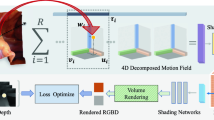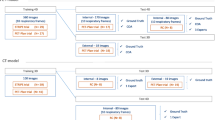Abstract
Purpose
Patient-specific surgical simulation imposes both practical and technical challenges. We propose a segmentation-free, modeling-free framework that creates medical volumetric models for intuitive volume deformation and manipulation in patient-specific surgical simulation.
Methods
The proposed framework creates a volumetric model based upon a new form of mesh structure, a Volume Proxy Mesh (VPM). The model can be generated in two phases: the vertex placement phase and mesh improvement phase. Vertices of a VPM are assigned to an initial location by curvature-based vertex placement method, and followed by mesh improvement performed by Particle Swarm Optimization (PSO).
Results
The framework is applied to several kidney CT volume data. Using the framework, the resulting models are closely tailored to the detailed features of the datasets. Moreover, the resulting VPM meshes can support broader spectrum deformation between the manipulated organ and its surrounding tissues. Progress in the mesh quality of the final mesh also shows that PSO is feasible for mesh improvement.
Conclusion
The framework was applied to several kidney CT volume datasets. Using the framework, the resulting models are closely tailored to the detailed features of the datasets. Moreover, the resulting VPM meshes can support broader spectrum deformation between the manipulated organ and its surrounding tissues. Evaluation of final mesh quality shows that PSO is feasible for mesh improvement.
Similar content being viewed by others
References
Soler L, Marescaux J (2008) Patient-specific surgical simulation. World J Surg 32: 208–212
Wittek A, Miller K, Kikinis R, Warfield S (2007) Patient-specific model of brain deformation: application to medical image registration. J Biomech 40(4): 919–929
Bao C, Wang BL (2008) A open source based general framework for virtual surgery simulation. In: Proceedings of international conference on biomedical engineering and informatics, pp 575–579
Bro-Nielsen M, Cotin S (1996) Real-time volumetric deformable models for surgery simulation using finite elements and condensation. Comput Graph Forum 15(3): C-57–C-66
Fong P (2009) Sensing, acquisition, and interactive playback of data-based models for elastic deformable objects. Int J Robot Res 28(5): 630–655
Plass A, Scheffel H, Alkadhi H, Kaufmann P, Genoni M, Volkmar F, Gruenfelder J (2009) Aortic valve replacement through a minimally invasive approach: preoperative planning, surgical technique, and outcome. Ann Thorac Surg 88(6): 1851–1856
Satava RM (2008) Historical review of surgical simulation—a personal perspective. World J Surg 32(2): 141–148
Chui CK, Wang ZL, Zhang J, Ong JS-K, Bian L, Teo JC-M, Yan CH, Ong SH, Wang SC, Wonge HK, Teoh SH (2009) A component-oriented software toolkit for patient-specific finite element model generation. Adv Eng Softw 40: 184–192
Cover S, Ezquerra N, O’Brien J (1993) Interactively deformable models for surgery simulation. IEEE Comput Graph Appl 13(6): 68–75
Ferrari V, Tuytelaars T, Gool G (2006) Simultaneous object recognition and segmentation from single or multiple model views. Int J Comput Vis 67(2): 159–188
Liu Q, Prakash E, Srinivasan M (2007) Interactive deformable geometry maps: Efficient modeling for interactive deformation of non-rigid 3D objects. Vis Comput 23(2): 119–131
Sutherland L, Middleton P, Anthony A, Hamdorf J, Cregan P, Scott D, Maddern G (2006) Surgical simulation: a systematic review. Ann Surg 243(3): 291–300
Gibson S, Fyock C, Grimson E, Kanade T, Kikinis R, Lauer H, McKenzie N, Mor A, Nakajima S, Ohkami H, Osborne R, Samosky J, Sawada A (1998) Volumetric object modeling for surgical simulation. Med Image Anal 2(2): 121–132
Haluck R, Marshall R, Krummel T, Melkonian M (2001) Are surgery training programs ready for virtual reality? A survey of program directors in general surgery. Virtual Real Surg Train Programs 193(6): 660–665
Nakao M, Hung KWC, Yano S, Yoshimura Y, Minato K (2009) Adaptive proxy geometry for direct volume manipulation. IEEE Pacific VIS (to appear)
Hung KWC, Nakao M (2009) Automated volume sampling optimization for direct volume deformation in patient-specific surgical simulation. In: IEEE international symposium on biomedical imaging: from nano to macro, pp 1051–1054
Kneebone R (2003) Simulation in surgical training: educational issues and practical implications. Med Educ 37: 267–277
Meyer M, Kirby RM, Whitaker R (2007) Topology, accuracy, and quality of isosurface meshes using dynamic particles. IEEE Trans Vis Comput Graph 13(6): 1704–1711
Kennedy J, Eberhart RC (1995) Particle swarm optimization. In: IEEE international conference on neural networks, pp 1942–1948
Eberhart RC, Shi Y (1998) Evolving artificial neural networks. In: Proceedings of 1998 international congress on neural networks and brain, pp PL5–PL13
Yilmaz A, Kuzuoglu M (2009) A particle swarm optimization approach for hexahedral mesh smoothing. Int J Numer Methods Fluids 60(1): 55–78
Trelea IC (2002) The particle swarm optimization algorithm: convergence analysis and parameter selection. Inf Process Lett 85(6): 317–325
Author information
Authors and Affiliations
Corresponding author
Rights and permissions
About this article
Cite this article
Hung, K.W.C., Nakao, M., Yoshimura, K. et al. Background-incorporated volumetric model for patient-specific surgical simulation: a segmentation-free, modeling-free framework. Int J CARS 6, 35–45 (2011). https://doi.org/10.1007/s11548-010-0456-1
Received:
Accepted:
Published:
Issue Date:
DOI: https://doi.org/10.1007/s11548-010-0456-1




